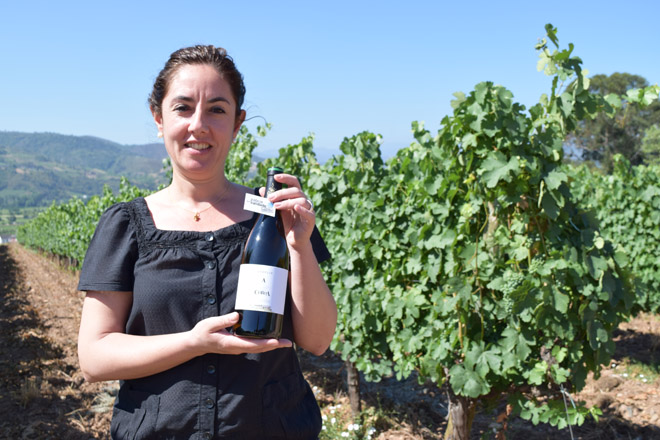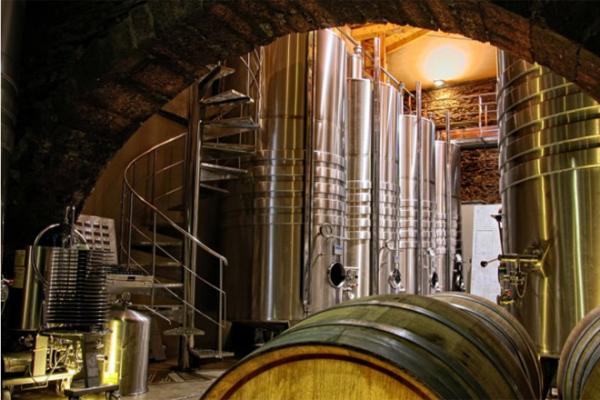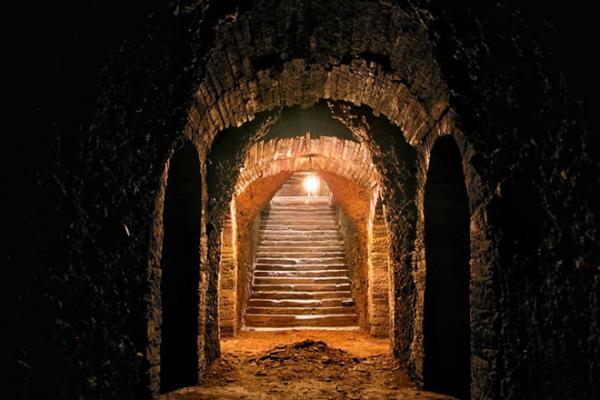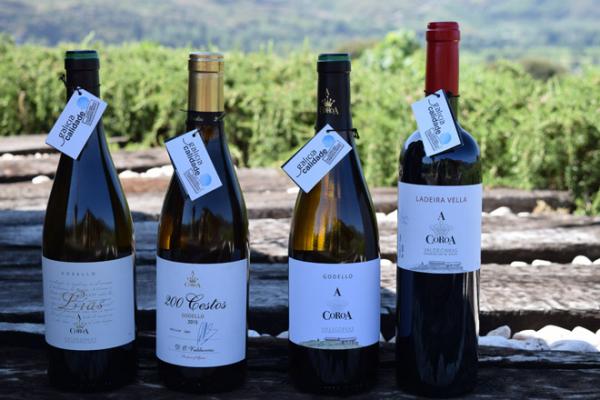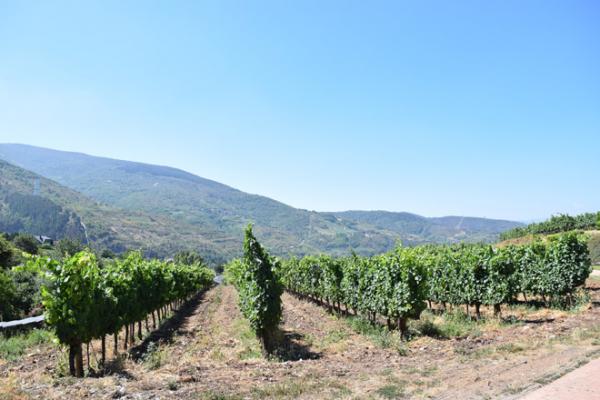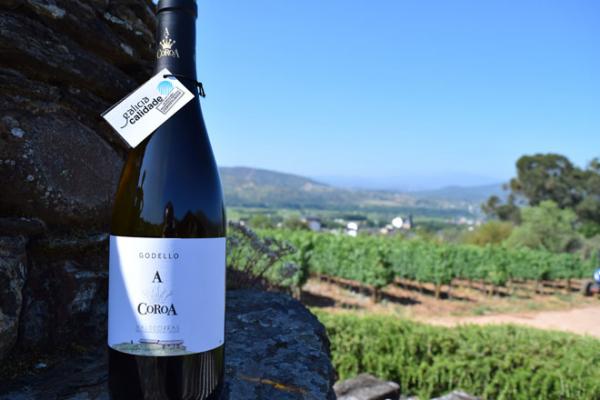A Coroa Godello 2016 is well on its way to becoming one of the Galician wines with the most awards this year, both at the national and international level. This single variety wine of the Valdeorras Denomination of Origin which uses ‘reina’ grapes, has just been awarded the Gold Medal at the international wine competition Mundus Vini in Germany and the 2017 Gold Bacchus in the Spanish Bacchus Awards.
“The awards corroborate that our commitment to quality is a good move and should also be the future strategy for the Valdeorras Denomination of Origin,” says Marta Sertaje Nogueira, the person responsible for the exports of Adega A Coroa, a family vineyard that employs 9 people directly and that from 2014 is also part of the Galicia Calidade seal.
Marta Sertaje Nogueira tells us the secrets of this winery that already exports 50% of its production and that made the commitment to quality its sign of identity.
Your A Coroa Godello 2016 is reaping awards in national and international competitions. What is the key to this success?
Our way of working is the same and the variations are due to the different types of weather during that year. In this sense, and despite the fact that 2016 was complicated in weather terms, the experts and the general public liked our wine, in which we put all our dedication. For us it is a pride and reaffirms that our philosophy of committing to quality rather than the quantity is the right thing.
In this sense, you are the only winery of the DO. Valdeorras that limits its production below the maximum allowed by the Regulatory Council. Why do you forego attaining maximum production?
In 2010 the Regulatory Council approved the inclusion of certified wines by controlled production. In this way, if the Regulatory Council right now allows up to 12,500 kg to be harvested per hectare, in Godello wineries like us that are certified in controlled production the maximum allowed is 8,000 kilograms per hectare of vineyard. We were the first winery that started with controlled production in Valdeorras and we remain the only that has taken this up.
For us it was a commitment to quality. We have a relatively young vineyard, our vines have an average of 30 years, and as our philosophy was to obtain quality, we chose to have less production to achieve better bunches of grapes, which is transferred to the wine, and also helps to extend the longevity of the strains and to improve their health status.
Over these years you have been expanding your wine catalogue. What you have on the market right now?
In total we sell some 90,000 bottles per year, of which 75,000 are A Coroa, a blend of Godello grapes from our plots, another 8,000 are A Coroa LÏAS; from 200 Cestos, a Godello from a plot in the sub-area of Bibei, we produce some 6,000 bottles; and we also offer a red wine, Ladeira Vella, from century-old vines of Garnacha Tintorera, from which we market some 1,500 bottles.
Since 2002, when we launched the winery, to 2009 we only had a single brand, A Coroa, and due to customer demand we are expanding our catalogue.
You are also one of the wineries of the Valdeorras Denomination of Origin that sells the most abroad. What are the keys to success in the internationalisation of wines with a small winery like this?
Right now we sell 50% outside Spain, especially to the United States and Puerto Rico, and also in Europe to the Netherlands, UK, Germany and Denmark, among others.
Three or four years ago we saw that Valdeorras and the Godello variety are in fashion. From the start we committed to doing things well and to producing quality wines and we are starting to reap the benefits.
The key to export is hard work, making investments and having continuity. The base part is taking care of the vines and looking after them every day because the wine is made in the vineyard. In our winery we have 4 people who are in the field every day and that is very important so that the strains are in good condition and we can achieve the best bunches of grapes.
Currently you have 16 hectares in production. Do you have any plans to continue increasing the surface area of the vineyard?
We have been able to place our wines in a medium-high level niche market, which was a struggle because in the beginning, when the Godello variety was not very well known, this was difficult.
Three or four years ago we saw that Valdeorras and the Godello variety are in fashion
Our philosophy continues by committing to quality, and the path we have taken so far shows that this was the right thing to do. That is why, at the moment we are going to continue with what we are doing, with controlled production and committed to obtaining the best grapes.
You are a winery that is also committing to wine tourism, which already represents an important part of your sales…
We receive visits and are part both of the Valdeorras Wine Route as well as the Inorde tourist train, set up by the County Council of Ourense. We like to receive visits because, besides the fact that we have a winery with history and unique architecture in the area that is worth visiting, we see that word of mouth from the people that visit us is the best advertising.
That is to say, we found that the visits to the winery are a very important way to promote ourselves and help that our wines to be advertised. We have direct selling in the winery and also through our website. We also send a lot of wine to individuals that place orders from us by phone or email. In this way, direct selling in the winery is growing year by year and now accounts for about 15% of our sales.
You are part of the Galicia Calidade seal. What does this give you?
In 2014 we decided to request to be certified by Galicia Calidade because it provides us with an extra and gives added value to our wines. The Galicia brand sells abroad and is associated with quality and Galicia Calidade carries out external promotions which are very useful for small and medium-sized wineries.
And how do you see the future of the Valdeorras Denomination of Origin?
I believe that the Denomination of Origin’s future is to continue committing to quality, not quantity, and to native varieties, so that Godello and Mencia de Valdeorras are recognosed as being wines that are differentiated and associated with quality. That is what is increasingly creating an interest so that both Galician and external wineries invest in this region.
A Coroa, a winery from the 18th century located on a Roman castro
The A Coroa winery was built around 1750 by a family of A Rua that produced wine to market. The site is called A Coroa, due to the Roman castro on which it stood and that dominated the A Rua valley. After a period of neglect the current owners, Ángel López and Roberto Fernández, bought the property in 1999 with the idea of rebuilding the old winery and starting to produce wine again. It was a reconstruction process using traditional materials such as slate and chestnut wood, and that respected the original architecture, including a spectacular underground cellar that remains intact.
The facilities were inaugurated in 2002 with the philosophy right from the start, which was to develop high-quality wines by committing to own production and the native Godello variety. “We have 20 hectares, of which 16 are in production, divided into 9 plots in the Valdeorras region and it allows us to take advantage of different soil types and micro-climates,” says Marta Sertaje.
“We have 9 vineyards spread across the different sub-areas of the DO to take advantage of the different micro-climates and soils”
In this way, the plots vary between those located in the sub-area of the River Sil, where slate soils predominate, while in the sub-area of the Bibei the soils are granite and with more altitude, which allows different wines to be produced, with more minerals, and more marked acidity due to the high altitude. In this sub-area in Lentellais, in the town council of O Bolo, a granite area was where the A Coroa winery acquired a 1.5 hectare vineyard four years ago. In one part, on the Property called 200 Cestos (200 Baskets), as this was what it produced, is where this ‘vino de pago’ is made from Godello vines that are between 60 and 70 years old, while the other part of the plot there are abandoned terraces that were recovered and replanted.
They also have a plot, O Rasedo, with hundred-year old vines of Garnacha Tintorera, which produce some 1,400 bottles of “A Coroa Ladeira Vella”, a unique wine with an important structure and 14 degrees of alcohol.
 English
English


